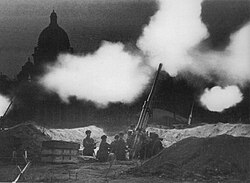Symphony No. 7 (Shostakovich)
Symphony No. 7 in C major, Op. 60 is a symphony by Dmitri Shostakovich. It is also called the Leningrad symphony. It was composed in 1941. It is very long, lasting about 75 minutes. It was first performed by the Bolshoi Theatre Orchestra on 5 March 1942. Shostakovich was awarded a Stalin Prize by the Soviet government for the symphony.
History of its composition
Shostakovich gave the symphony its title because it is about what was happening in Leningrad in 1941. It was during the World War II and the German army had invaded the Soviet Union and blocked communication between the city of Leningrad (now called St Petersburg) and the rest of the world. Conditions were terrible: the people hardly had any food to eat and they were very cold in the winter. About a million people died during the siege.
Shostakovich lived in fear most of his life because if Josef Stalin, the Soviet dictator, did not like his music he could have been sent to prison or put to death. Sometimes Shostakovich was made a hero by the government and sometimes he was told that his music was not good because it was not in the style that the government thought he should write it in. The symphony was very popular at first in countries that fought on the same side as Russia in World War II, as well as in Russia. It was performed many times in the United States and the United Kingdom. Many people in these countries liked the symphony because it seemed to show the Russians as heroes fighting to save their city from the Germans. Later, during the Cold War, many people in these same countries did not like the work very much, because the Russians were now their enemies and they thought that music written there was propaganda meant to show Russia and its leaders as better than other countries and their leaders. In more recent years, people have once more changed their minds about the meaning of the music. The music is now thought by some people who study music to show how cruel Stalin was as well as the terror of the Nazi invasion. Other people still think it was meant to support the Russian government and army as they fought the Germans, and to remember the people who died fighting.
One of the reasons it is so hard to know what the symphony means is that people disagree about when Shostakovich started writing it. If he started it before the war began, it is probably at least partly about the Soviet government, but if he started it during the war, it might be only about the war.
After the first performance on 5 March 1942 in Kuybïshev (now called Samara), it was soon performed in Moscow, and then in Leningrad, which was still surrounded by the German army at the time. A copy of the music was smuggled out to the West on microfilm. It was performed by Sir Henry Wood in London at the BBC studios on 22 June and the next week at a Promenade Concert. On 19 July it was played in New York by the NBC Symphony Orchestra conducted by Arturo Toscanini in a studio concert played on the radio throughout the United States.
The Music
The work has four movements:
The first movement is a long, dramatic movement. The middle part of this movement is a march, with a repeated rhythm on the snare drum, starting very softly, with the tune first heard in the strings who are playing "pizzicato" (plucking the string instead of playing with the bow). Each time the tune is played it becomes louder. People used to think that this theme was about the invading German Nazi army, but now some people think it might instead be about the way the Soviet government changed the city of Leningrad, or about both of these things. The second movement is called a scherzo. It is a more light-hearted movement after the tension of the first movement. The third movement is slow and full of strong emotions. The composer said that it was supposed to show the city of Leningrad at sunset. The last movement is faster again, and brings back parts of the music from earlier in the piece, but it is not clear whether the ending is serious or not.
The orchestra is very large and has parts for the flute, piccolo, oboe, cor anglais, clarinet, bass clarinet, bassoon, contrabassoon, French horn, trumpet, trombone, tuba, piano, harp, violin, viola, cello, and double bass, as well as many percussion instruments.



